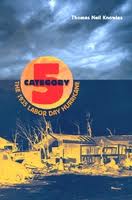Tis the season…hurricane that is
 My latest read is Thomas Neil Knowles’ book Category 5 – The 1935 Labor Day Hurricane. The book was Published by the University Press of Florida and is the result of 12 years of research and many interviews. This is actually my second book on this hurricane. Three years ago I read Phil Scott’s 2006 book, Hemingway’s Hurricane, so I was already familiar with the tragic events of the 1935 Labor Day weekend. Even with this background I found the book very interesting. Knowles graphically portrays the lives of Florida Keys residents immediately before the hurricane, during the day of the storm and the aftermath. Both books address the tragic loss of the hundreds of World War I veterans sent to the Keys to build a continuous road link to Key West. Unlike Scott’s book, Knowles provides more information by way maps and graphics. Both books reproduce many photographs of the aftermath documenting the total devastation and lose of life. Through his vivid writing style, Knowles gives us a glimpse of life on the Florida Keys during the height of the depression and the life & death struggles experienced on that day. Knowles compliments the human stories with just enough factual background on hurricanes, the US Weather Service and the Florida East Coast Railway to keep the narrative flowing for easy reading.
My latest read is Thomas Neil Knowles’ book Category 5 – The 1935 Labor Day Hurricane. The book was Published by the University Press of Florida and is the result of 12 years of research and many interviews. This is actually my second book on this hurricane. Three years ago I read Phil Scott’s 2006 book, Hemingway’s Hurricane, so I was already familiar with the tragic events of the 1935 Labor Day weekend. Even with this background I found the book very interesting. Knowles graphically portrays the lives of Florida Keys residents immediately before the hurricane, during the day of the storm and the aftermath. Both books address the tragic loss of the hundreds of World War I veterans sent to the Keys to build a continuous road link to Key West. Unlike Scott’s book, Knowles provides more information by way maps and graphics. Both books reproduce many photographs of the aftermath documenting the total devastation and lose of life. Through his vivid writing style, Knowles gives us a glimpse of life on the Florida Keys during the height of the depression and the life & death struggles experienced on that day. Knowles compliments the human stories with just enough factual background on hurricanes, the US Weather Service and the Florida East Coast Railway to keep the narrative flowing for easy reading.
In his epilogue, Knowles addresses whether if could happen again? The 1935 population of the Florida Keys at the center of the hurricane was 284 residents. In 2000 the same area had a population of 6,846. Current estimates are that an evacuation of the Keys would take 36 hours. I don’t know if this estimate takes into account the Katrina experience but it seems to be a low end estimate to me. The Labor Day Hurricane (they weren’t given names until 1953) went from Category 1 to Category 5 in the 36 hours prior to landfall. Knowles thus, answers the question “Unfortunately, the answer is yes, and such an event has the potential to be much worse in terms of the number of causalities and the amount of property damage.”
Anyone contemplating a seaside home in the southeast should read either of these books. First as checkpoint on the potential devastation that a hurricane can reek and second, as motivation to evacuate the shore area when a hurricane threatens. Unlike 1935, today’s technology of satellites, hurricane hunter aircraft, and knowledge of hurricane physics make any loss of life avoidable.

Powered by ScribeFire.
Posted: September 6th, 2010 under Books.


